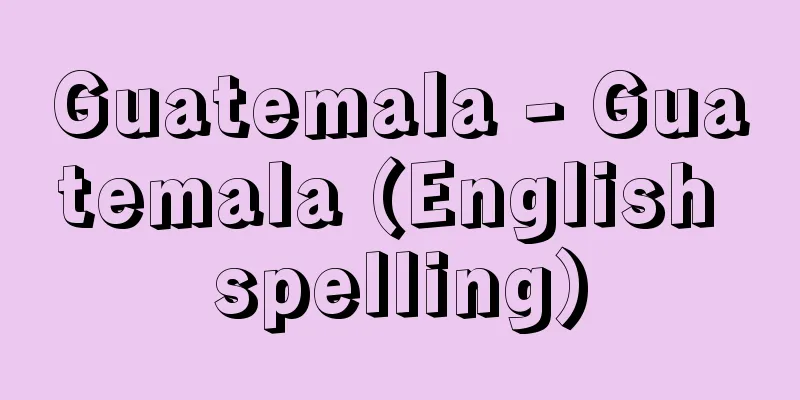Guatemala - Guatemala (English spelling)

|
A country in central Central America. Its official name is the Republic of Guatemala. It borders Mexico to the north and west, Honduras and Belize to the east, and El Salvador to the southeast. It has an area of 109,117 square kilometers and a population of 11,986,558 (2002). Its capital is Guatemala City. It is the birthplace of the ancient Mayan civilization and has the highest ratio of indigenous people among Latin American countries. [Naoko Kurihara and Iyo Kunimoto] NatureThe country is divided into four main regions: the Pacific coastal lowlands, the Sierra Madre Mountains and the Central Plateau, the Caribbean coastal lowlands, and the Petén Plain. The Pacific coastal lowlands are small, but in recent years banana plantations have taken over the Caribbean coastal lowlands. The Sierra Madre Mountains reach an elevation of over 3,500 meters on the border with Mexico, and drop eastward to 2,000 meters on the border with Honduras. The country is dotted with volcanoes, including the highest peak in Central America, Tajumulco (4,220 meters), and crater lakes such as Lake Atitlan, Lake Amatitlan, and Lake Ayarsa. The Central Plateau, which continues from the Sierra Madre Mountains, is carved by faults running from the northeast to the southwest, but the river valley plains are covered with thick volcanic ash, forming fertile agricultural areas, and the foothills in particular are the main producers of coffee, the country's main industry. The Sierra Madre Mountains and the Central Plateau make up 60% of the country's land area. The region is also prone to earthquakes. A major earthquake in 1773 destroyed the former capital, Antigua, and a similar earthquake struck the center of the country in February 1976, killing 23,000, injuring 77,000 and destroying 1 million houses, prompting an international relief effort. The Caribbean coastal lowlands extend along the coast of the Gulf of Honduras, and the Motagua River valley plain penetrates deeply into the central plateau. The Petén plain in the north occupies about one third of the country. It is the southern half of the Yucatan Peninsula and consists of limestone plateaus with marshes and karst topography, which is completely different from the rest of Central America in terms of topography. In terms of climate, the lowlands along the Pacific coast have an average annual temperature of over 25°C and an average annual precipitation of 2000 mm. The country is divided into a rainy season and a dry season, with savannahs predominating. The central highlands are also divided into a rainy season and a dry season, but both the amount of precipitation and temperature vary with altitude. The annual precipitation in the capital, Guatemala City, is 1316 mm, while in Quetzaltenango it is 670 mm. The average annual temperature is 15-20°C, and the climate is comfortable throughout the year, belonging to an alpine temperate climate. The Caribbean coastal lowlands and the Petén plain are dominated by a hot and humid tropical rainforest climate. [Naoko Kurihara and Iyo Kunimoto] historyBefore it was conquered by Spanish explorer Pedro de Alvarado (1485-1541) in 1522, Tikal was the center of Maya civilization, flourishing in the tropical jungle. Between 300 and 900 AD, Tikal, located north of Lake Peten, developed an advanced civilization that included pictographs, an accurate solar calendar, a base 20 system with a zero number, sophisticated sculptures, and paintings. In 1524, the capital of Spanish Guatemala was first established in the indigenous city of Iximche, but it was moved to Antigua after destruction by earthquakes and floods. In 1773, Antigua was destroyed by earthquakes and other disasters, and in 1776 the city was rebuilt in the current capital, Guatemala City, and became the capital of the Viceroy of Guatemala, the base of Spanish colonial rule in Central America. In 1821, the Viceroy of Guatemala gained independence, and from 1822 to 1823 it was annexed by the Mexican Empire led by Iturbide, but with the collapse of the empire the Federal Republic of Central America was formed. However, due to intense conflicts of interest between the various regions, the Federal Republic was dissolved in 1839, and Guatemala became an independent nation on its own. After independence, Guatemala experienced numerous coups, and a succession of dictators emerged and seized real power. First, President Carrera, who was the direct cause of the collapse of the Central American Federation, was elected president for life and held real power for 27 years. After President Carrera died of illness in 1865, Barrios seized the presidency by force, and promoted a liberal economic policy while working to unify the countries of Central America, dying in battle in El Salvador when he invaded the country for that purpose. The next dictator, Estrada, who became president in a coup in 1889, held real power until 1920, when in his later years he became a tyrant with many eccentricities and was declared a "madman" by the parliament, dying in prison four years later. The next dictator was the military officer Ubico, who was elected president in 1931 on a platform of reform, just after the coffee monoculture economy collapsed in the Great Depression of 1929. He held power for 15 years until he was ousted by a national uprising in 1944. The reform movement that ousted dictator Ubico from power implemented reform policies under two presidents, Arevalo and Árbenz, which would later be called the "Guatemalan Revolution." The revolutionary government that enacted the Agrarian Reform Law in 1952 came into conflict with the United Fruit Company, an American company that operated vast banana plantations that owned about half of Guatemala's arable land at the time. The United States considered the Guatemalan government, which was implementing social reforms, to be a communist regime, and had the CIA (Central Intelligence Agency) intervene to overthrow the government. A pro-American military regime then continued for 29 years until a civilian government was established. The anti-government guerilla movement rose up in opposition to this authoritarian government. The anti-government movement, which formed a unified left-wing guerrilla organization in 1960, expanded its support base among farmers, workers, and urban residents, and in 1982 formed the Guatemalan National Revolutionary Unity Union. Although the transition to civilian rule was realized in 1986, the civil war continued, and the government's guerrilla operations to wipe them out became more brutal in proportion to the intensity of the guerrilla activities, with the number of people who lost their lives to kidnappings and murders by the military reaching more than 300,000. Many people from Guatemala, which had become a battlefield, became refugees and fled to neighboring Mexico. In 1991, under pressure from international public opinion, talks toward peace between the two sides began. However, due to strong opposition from the military, peace negotiations did not progress, and after many twists and turns, a peace agreement was not reached until December 1996. This marked an end to the 36-year long civil war. [Naoko Kurihara and Iyo Kunimoto] PoliticsThe country has a constitutional republic with three separate powers, and the current constitution was enacted in 1986. The president, who is the Minister of State, is elected by the party that receives a majority of the votes of citizens over the age of 18. If no party receives a majority, a runoff election is held between the top two parties. The president serves a four-year term, and reelection is prohibited. The parliament is unicameral, with 113 members, each with a four-year term. In the 1994 election, there was a boycott of the election due to lobbying from civil society groups and labor unions, and the abstention rate was nearly 80%. Political parties include the Guatemalan Republican Front (FRG), which won first place in the election, the National Progressive Party (PAN), which came in second, the Christian Democratic Party (PDCG), and the National Central Union. The presidents who took office were Ramiro de Leon Carpio (1942-2002) in 1993, Alvaro Enrique Arzu Irigoyen (1946-) of the PAN in 1996, Alfonso Antonio Portillo Cabrera (1951-) of the FRG in 2000, and Oscar Berger of the right-wing Grand National Alliance (GANA) in 2004. [Naoko Kurihara and Iyo Kunimoto] economyGuatemala has the largest population of any Central American country and is blessed with a diverse natural environment and resources. Thanks to its fertile soil and a country with a varied climate, it is possible to cultivate a wide variety of agricultural products, making agriculture Guatemala's core industry, but light industry, centered on manufacturing, is also relatively well developed and plays an important role. Agriculture accounted for 25% of gross domestic product (GDP) (1994) and 37% of total exports, and in addition to basic crops for domestic consumption such as corn and wheat, coffee, sugar and bananas are important export products. Guatemalan coffee is a high-quality Arabica variety, mainly produced in the central highlands, and accounts for approximately 20% of total exports. Meanwhile, bananas, which were first cultivated in Central America by the United Fruit Company, were initially cultivated on plantations in the lowlands along the Pacific coast in the early 20th century. Today, banana plantations have moved to the Caribbean coast, and the main banana producing areas in Central America have shifted to Honduras and Costa Rica. Other than these, the relatively diversified agricultural sector also exports cotton, tobacco, fruit, and beef. The industrial sector grew rapidly from the 1960s to the early 1970s, with the development of manufacturing industries such as food, beverages, textiles, and clothing targeting the Central American market, but was hit hard by the stagnation of the Central American Common Market (CACM) and the 36-year civil war. However, with the end of the Central American conflict and the return of stability within the region, the industry has been revitalizing, with industrial products accounting for one-third of total exports in 1993. Furthermore, the oil resources developed after the oil crisis of the 1970s are now at a level where they can be exported, albeit in small quantities. [Naoko Kurihara and Iyo Kunimoto] Society and CultureThe population is made up of indigenous people, ladinos (mixed races), and Europeans. 42% of the population is indigenous, making it the country with the highest percentage of indigenous people in Latin America. The indigenous people are of Mayan descent, and are divided into about 20 language groups, including Quiche, the largest in population. Spanish is the official language, but indigenous languages are also widely spoken. The strong traditional culture and identity of the Mayan people has made national integration difficult, but since the end of the civil war, new movements have been active aiming for a multi-ethnic and multi-cultural society. People who have abandoned the traditional indigenous lifestyle and those of mixed race between indigenous and white people are called ladinos, and about 50% of the population falls into this category. Six years of primary education are compulsory, and the adult literacy rate is 68% (1999). The national University of San Carlos is a traditional university founded in 1676 during the colonial period. There are more than 70,000 university students (1995). [Naoko Kurihara and Iyo Kunimoto] "The Structure of the Central American and Caribbean Crisis" by Hosono Akio, Osonoi Shigeo, and Tanaka Takashi (1987, Yuhikaku Publishing) " "Central America in Transition" by Kamo Yuzo, Hosono Akio, and Harada Kinichiro (1990, Omura Shoten) " "Post-Cold War Central America: From Conflict to Peace" edited by Ishii Akira (1996, Institute of Developing Economies) [References] | | | | | | | | | | | | | | | [Complementary material] |"> Guatemala flag ©Shogakukan Illustration/Shogakukan Creative "> Guatemala Location Map A caldera lake at an altitude of about 1,500 m at the southern end of the Sierra Madre mountain range. Sololá State, Guatemala ©Shogakukan "> Lake Atitlan Source: Shogakukan Encyclopedia Nipponica About Encyclopedia Nipponica Information | Legend |
|
中央アメリカ中部の国。正式名称はグアテマラ共和国República de Guatemala。北と西をメキシコ、東をホンジュラスとベリーズ、南東をエルサルバドルと国境を接する。面積10万9117平方キロメートル、人口1198万6558(2002)。首都はグアテマラ市。古代マヤ文明発祥の地であり、ラテンアメリカ諸国のなかでももっとも先住民人口の比率の高い国である。 [栗原尚子・国本伊代] 自然国土の東西方向に広がる太平洋沿岸低地、シエラ・マドレ山脈と中央高原、カリブ海沿岸低地およびペテン平原の四つの地域に大別される。太平洋沿岸低地は狭小であるが、近年バナナのプランテーションがカリブ海沿岸低地にかわって拡大している。シエラ・マドレ山脈は、メキシコとの国境では標高3500メートル以上に達し、東に向かって低くなり、ホンジュラスとの国境では2000メートルになる。中央アメリカの最高峰タフムルコ火山(4220メートル)をはじめとする火山や、火口湖のアティトラン湖、アマティトラン湖やアヤルサ湖などが点在する。シエラ・マドレ山脈に続く中央高原は、北東から南西に向かう断層に刻まれているが、河谷平野は厚い火山灰に覆われて肥沃(ひよく)な農業地帯を形成し、とくに山麓(さんろく)は同国の主要な産業であるコーヒー栽培の主産地となっている。シエラ・マドレ山脈と中央高原で国土の60%を占める。 この地域はまた地震の多発地帯でもある。1773年の大地震では旧首都アンティグアが壊滅したが、1976年2月にも中央部で大地震があり、死者2万3000、負傷者7万7000、倒壊家屋100万戸という被害を出し、国際的な救援活動が展開された。 一方カリブ海沿岸低地はホンジュラス湾岸に広がり、モタグア川河谷平野が中央高原にまで深く入り込んでいる。北部のペテン平原は国土の約3分の1を占める。ユカタン半島の南半分にあたり、湿地とカルスト地形を伴った石灰岩台地からなり、中央アメリカの他の地体構造とまったく異なっている。 気候は、太平洋沿岸低地では年平均気温が25℃を超え、年降水量は2000ミリメートルである。雨期と乾期に分かれ、サバンナが卓越する。中央高原は同様に雨期と乾期に分かれるが、雨量、気温とも標高によって異なる。首都グアテマラ市の年降水量は1316ミリメートル、ケサルテナンゴでは670ミリメートルである。年平均気温は15~20℃で、高山性温帯気候に属し年間を通じて快適である。カリブ海沿岸低地やペテン平原は、高温多湿な熱帯雨林気候に支配されている。 [栗原尚子・国本伊代] 歴史1522年、スペインの探検家ペドロ・デ・アルバラドPedro de Alvarado(1485―1541)によって征服される以前は、熱帯のジャングルの中に栄えたマヤ文明の中心地であった。ペテン湖の北のティカルでは、紀元後300~900年の間に、絵文字、精密な太陽暦、ゼロの数字を用いた二十進法、洗練された彫刻、絵画など、高度な文明を発達させていた。 1524年先住民の都イシムチェに初めてスペイン領グアテマラの首都が建設されたが、地震と大水害による破壊のためアンティグアに遷都された。1773年アンティグアが地震などの災害のために破壊され、1776年に現在の首都グアテマラ市に都市が再建設され、グアテマラ総督領の首都として、中央アメリカのスペイン植民地支配の拠点となった。1821年グアテマラ総督領は独立し、1822~1823年の間はイトゥルビデの率いるメキシコ帝国に併合されたが、同帝国の崩壊とともに中米連邦共和国が結成された。しかし各地域の利害が激しく対立して同連邦共和国は1839年に解体し、グアテマラは単独の独立国家となった。 独立後のグアテマラでは、数多くのクーデターが繰り返され、独裁者が次々と現われて実権を握った。まず中米連邦崩壊の直接の原因をつくったカレーラ大統領はみずから定めた終身大統領の地位に就いて27年間実権を握った。1865年にカレーラ大統領の病死後武力で大統領の地位を手に入れたバリオスは、自由主義経済政策を推進すると同時に中米諸国の統一につとめ、その目的で侵略したエルサルバドルにおいて戦死した。1889年の政変で大統領となった次の独裁者エストラーダは1920年まで実権を握り、晩年には奇行の多い暴君と化して議会によって「狂人」と議決され、その4年後に獄中で死亡した。 次の独裁者は1929年の世界恐慌でコーヒー・モノカルチュア(単一作物生産)経済が破綻した直後の1931年に、改革の政治を標榜して大統領に選出された軍人ウビコである。彼は1944年に国民の蜂起(ほうき)で追放されるまで15年間実権を握った。独裁者ウビコを権力の座から引きずり降ろした改革運動は、アレバロとアルベンスという2人の大統領の下で、のちに「グアテマラ革命」とよばれる改革の政治を行った。 1952年に農地改革法を制定した革命政府は、当時グアテマラの可耕地の約半分を所有していた広大なバナナ・プランテーションを経営するアメリカ資本ユナイテッド・フルーツ社と対立。アメリカは社会改革を実施するグアテマラ政府を共産主義政権とみなし、CIA(中央情報局)に介入させて政府を転覆させた。その後文民政権が樹立されるまでの29年間、親米主義を標榜する軍事政権が続いた。 この軍部による強権政治に反対して立ち上がったのが反政府ゲリラ運動である。1960年に左翼ゲリラ統一組織を結成した反政府運動は、農民・労働者・都市住民の間に支持層を広めていき、1982年にグアテマラ全国革命統一連合を結成。1986年に民政移管が実現したがその後も内戦状態は続き、ゲリラ活動の激しさに比例して政府軍のゲリラ掃討作戦も残虐さを増し、軍部による拉致(らち)・殺害によって命を失った国民の数は30万以上に上ったとされる。このように戦場となったグアテマラから多くの国民が難民となって隣国メキシコに避難した。1991年に国際世論の圧力で両者間の和平に向けた話し合いが始まった。しかし軍部の強い反対から和平交渉は進展せず、紆余曲折(うよきょくせつ)を経て和平合意が成立したのは1996年12月であった。36年間という長い内戦状態に終止符が打たれたのである。 [栗原尚子・国本伊代] 政治三権分立による立憲共和制をとり、現行の憲法は1986年に制定されたものである。国家元相である大統領は18歳以上の国民の投票の過半数を得た政党から選出される。過半数を取得した政党がない場合は、上位2党による決選投票が行われる。大統領の任期は4年で、再選は絶対禁止となっている。議会は一院制で、任期4年の113名の議員で構成される。1994年に行われた選挙では、市民団体や労働組合の働きかけで選挙のボイコットが行われ、棄権率はほぼ80%に達した。政党には、この選挙で第一党となったグアテマラ共和戦線(FRG)、第2位の国民進歩党(PAN)のほかに、キリスト教民主党(PDCG)、国民中央同盟などがある。大統領には、1993年にデ・レオンRamiro de Leon Carpio(1942―2002)、1996年にPANのアルスAlvaro Enrique Arzu Irigoyen(1946― )、2000年にFRGのポルティージョAlfonso Antonio Portillo Cabrera(1951― )、2004年に右派・国民大連合(GANA)のオスカル・ベルシェOscar Bergerがそれぞれ就任した。 [栗原尚子・国本伊代] 経済グアテマラは中米諸国中最大の人口を擁し、多様な自然環境と資源に恵まれている。肥沃(ひよく)な土壌と気候の変化に富む国土のおかげでさまざまな農産物の栽培が可能である農業はグアテマラの基幹産業であるが、製造業を中心とする軽工業も比較的発達しており重要な役割を果たしている。農業は国内総生産(GDP)の25%(1994)、輸出総額の37%を占め、トウモロコシや小麦など国内消費用基礎作物のほかに、コーヒー、砂糖、バナナが重要な輸出産品となっている。グアテマラ・コーヒーは良質のアラビカ種で、中央高原一帯がおもな生産地であり、輸出総額の約20%を占める。 一方ユナイテッド・フルーツ社が中米地域で最初に進出して栽培したバナナは、当初太平洋岸の低地に拓かれたプランテーションで20世紀の初頭に栽培が始まった。現在ではカリブ海岸地域にバナナ・プランテーションが移動しており、さらに中米地域のバナナの主要生産地はホンジュラスやコスタリカに移っている。その他に比較的多角化された農業部門では、綿花、タバコ、果物、牛肉なども輸出されている。 工業部門は、1960年代から1970年代初めにかけて急成長をとげ、食品、飲料、繊維、衣料などの製造業が中米市場向けに発達したが、中米共同市場(CACM)の停滞と36年におよんだ内戦によって大きな打撃を受けた。しかし中米紛争の終結と域内の安定回復の下で活性化しつつあり、1993年には輸出総額の3分の1を工業製品が占めるに至っている。さらに1970年代の石油危機後に開発が行われた石油資源は、現在では少量ではあるが輸出するレベルにある。 [栗原尚子・国本伊代] 社会・文化先住民、ラディノladino(混血)、ヨーロッパ系の人々で構成される。国民の42%が先住民からなり、ラテンアメリカで先住民人口が占める割合のもっとも高い国である。先住民はマヤ系民族で、もっとも人口規模の大きいキチェをはじめとして約20の言語集団に分かれている。スペイン語が公用語であるが先住民の固有の言語も広く話されている。マヤ系民族の強い伝統文化とアイデンティティは国民統合を難しくしてきたが、内戦の終結後、多民族・多文化社会を目ざす新しい動きが活発になっている。先住民の伝統的生活様式を捨てた人々および先住民と白人との混血はラディノとよばれ、国民の約50%がこの分類に入る。初等教育6年間が義務教育で、成人の識字率は68%(1999)となっている。国立のサン・カルロス大学は植民地時代の1676年に創設された伝統ある大学。大学生の数は7万を超す(1995)。 [栗原尚子・国本伊代] 『細野昭雄・遅野井茂雄・田中高著『中米・カリブ危機の構図』(1987・有斐閣)』▽『加茂雄三・細野昭雄・原田金一郎著『転換期の中米地域』(1990・大村書店)』▽『石井章編『冷戦後の中米―紛争から和平へ』(1996・アジア経済研究所)』 [参照項目] | | | | | | | | | | | | | | | [補完資料] |"> グアテマラの国旗 ©Shogakukan 作図/小学館クリエイティブ"> グアテマラ位置図 シエラ・マドレ山脈南端、標高約1500mにあるカルデラ湖。グアテマラ ソロラ州©Shogakukan"> アティトラン湖 出典 小学館 日本大百科全書(ニッポニカ)日本大百科全書(ニッポニカ)について 情報 | 凡例 |
<<: Guatemala City (English spelling)
>>: Guadiana [river] - Guadiana
Recommend
Ganzhou - Kanshu
A city in the southern part of Jiangxi Province, C...
Kim Jong Il
The second supreme leader of North Korea (Democra...
Alpine bearberry
...It is distributed from central Honshu northwar...
Writing - Writing
〘noun〙① The act of writing and recording character...
Archidamus II
? - 427 BCE King of Sparta. Reigned 469?-427 BC. F...
Availability
Availability. One of the items listed in RAS and R...
Index number
A statistical value that is created to be easily ...
Albanian - Albanian
It is a branch of the Indo-European language fami...
The Imperial Chronicles
A chronicle that lists the main events for each re...
Thomas Gainsborough
British painter. Born in Sudbury, he went to Lond...
Bronze vessels from the Yin and Zhou periods
…Everyday items and ornaments made from metals, a...
Johann Sigismund
...Elector Joachim II (1535-71) adopted Lutherani...
Angel Falls - Angeltaki
Salto Angel is a waterfall in Auyantepui, Guiana H...
Paratype
...This is called the type method, and is the pro...
Wooden stupa - Itatoba
A long, narrow board with Sanskrit characters, sut...









